
Title: 3 Fascinating Reasons Why The ‘World’s Largest Living Organism’ Is Truly Larger Than Life
As we gaze at the majestic beauty of Pando, the world’s largest living organism, it is impossible not to be awed by its sheer scale and resilience. Spanning over 100 acres, this enormous quaking aspen colony has managed to thrive for thousands of years, defying the odds against countless challenges. Here are three fascinating reasons why Pando truly stands out as an extraordinary entity.
Firstly, its age is unparalleled. Estimated to be between 9,000 and 16,000 years old, Pando’s longevity offers a unique window into the past. As it has witnessed monumental shifts in the planet’s history, from the end of the last Ice Age to the rise of modern society, this ancient organism provides invaluable insights into how ecosystems adapt over time. Imagine the countless creatures that have lived and thrived within its vast network – what an incredible story Pando could tell if only it could speak.
Secondly, its ability to regenerate is a testament to the wonders of nature. Pando’s unique capacity for suckering, where new stems arise from its vast root system, allows it to recover from environmental disturbances like wildfires. Its adaptability is truly remarkable, having survived and even thrived under the pressures of fire and grazing by deer and elk. However, this regenerative prowess is not without its challenges – as overgrazing has become a critical issue, Pando’s health is at risk due to the absence of apex predators and climate change.
Lastly, the intricate web of relationships within its ecosystem is truly fascinating. As a giant organism, Pando plays host to countless other living beings that have evolved alongside it over millennia. The interconnectedness of this network highlights the interconnected nature of life itself – an ecological tapestry woven from the threads of predator and prey, symbiotic bonds and competition for resources. It serves as a powerful reminder of our responsibility to conserve and protect these delicate relationships, lest we risk unraveling the very fabric that binds us.
In conclusion, Pando is not just a single tree; it embodies the collective wisdom of millennia of natural evolution.
Source: www.forbes.com


